Vinyl awning windows provide great durability and energy efficiency, making them a smart choice for your home. They’re low-maintenance and resistant to warping, fading, and moisture, which means you won’t have to worry about costly repairs. However, there are environmental concerns related to production and disposal. While they can save you money on energy bills and replacements over time, the initial cost may be higher than other materials. So, while they’re a solid option, it’s important to weigh the pros and cons thoroughly before deciding. Explore further to discover more insights and helpful comparisons.
Overview of Awning Windows
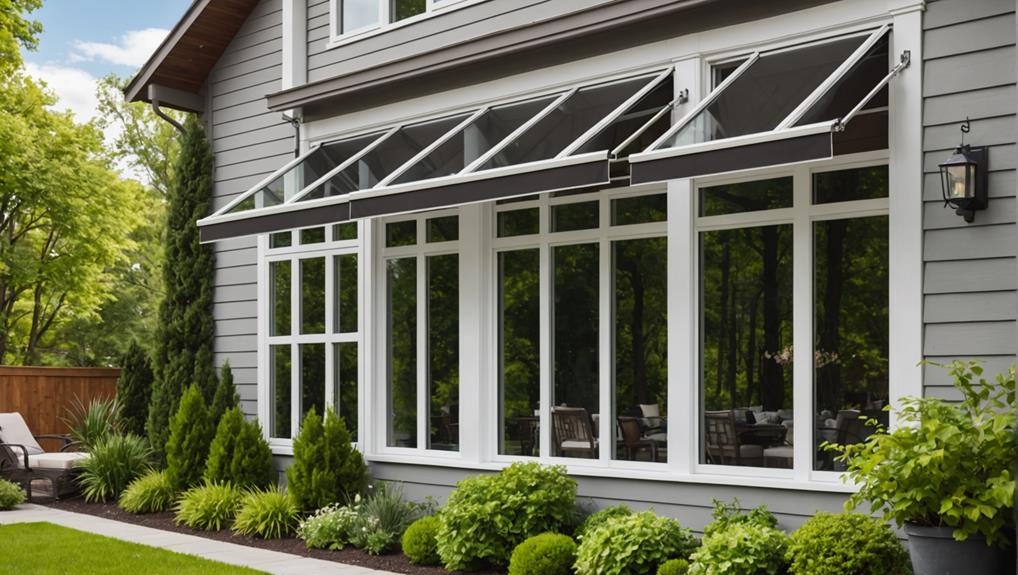
Awning windows are versatile and stylish options that open outward from the bottom, allowing for ventilation even in light rain. You’ll find that these windows come in various awning window styles, making them suitable for different architectural designs. Whether you prefer a contemporary look or a more traditional feel, there’s likely an awning window that fits your aesthetic.
When considering window operation methods, awning windows are particularly user-friendly. They typically feature a crank mechanism, allowing you to easily open and close the window with minimal effort. This design not only enhances usability but also guarantees a tight seal when closed, contributing to energy efficiency.
You might also appreciate that awning windows can be combined with other window types, such as fixed windows, to create stunning visual effects and maximize natural light. Their ability to provide airflow while keeping rain out makes them ideal for kitchens, bathrooms, and other spaces where ventilation is essential.
Benefits of Vinyl Awning Windows
Offering a blend of durability and style, vinyl awning windows are an excellent choice for homeowners seeking low-maintenance solutions. One of the standout features of these windows is their outstanding ventilation benefits. You can easily open them from the bottom, allowing fresh air to flow in while keeping out rain and debris. This design is particularly useful during light rains, providing you the chance to enjoy the breeze without worrying about getting wet.
Additionally, vinyl awning windows come in a variety of style variations, allowing you to match them with your home’s aesthetics. Whether you prefer a modern look or something more traditional, you’ll find options that work for your design preferences. The ability to customize the color and finish guarantees that these windows can seamlessly blend into your space.
Another great advantage is that they require minimal upkeep. Unlike other materials, vinyl won’t warp or peel, saving you time and money on maintenance. With their combination of functionality and visual appeal, vinyl awning windows make a smart investment for any homeowner looking to enhance both comfort and style.
Durability of Vinyl Materials
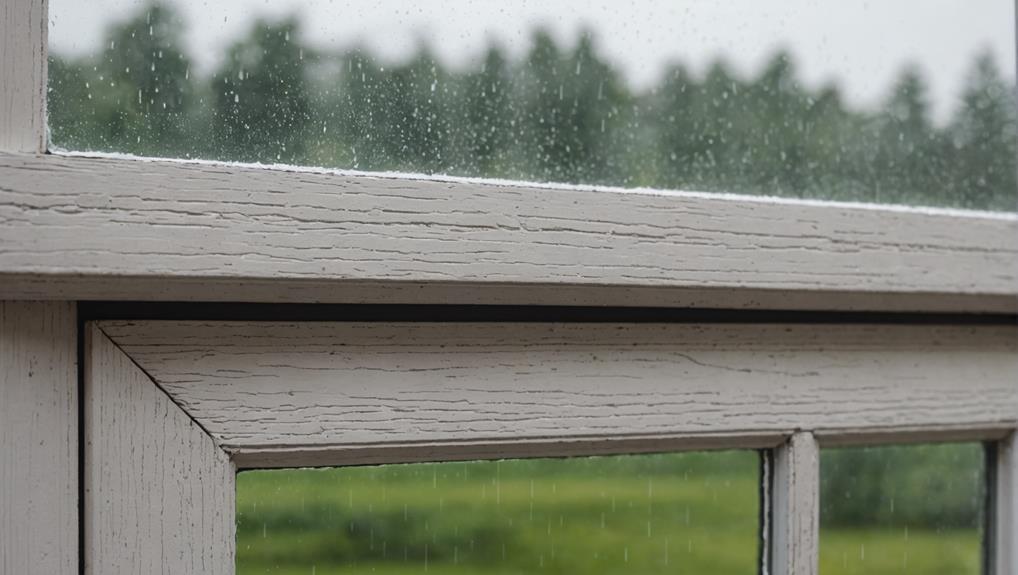
Vinyl materials stand out for their exceptional durability, resisting warping, cracking, and fading over time. When you choose vinyl windows, you’re investing in products that can withstand various weather conditions, from intense sunlight to heavy rain and snow. This weather resistance guarantees that your windows maintain their appearance and functionality for years to come.
In terms of lifespan expectations, vinyl windows generally last longer than many other materials, often exceeding 20 years with minimal maintenance. Unlike wood, which can rot or require frequent repainting, vinyl doesn’t absorb moisture, making it less prone to damage. Plus, it won’t rust or corrode, which is a significant advantage in humid or coastal environments.
You can trust that vinyl windows won’t only enhance your home’s aesthetic appeal but also provide long-term value. They’re designed to handle everyday wear and tear, making them a smart choice for homeowners looking for reliability.
Energy Efficiency Advantages
Energy efficiency is a standout feature of vinyl windows, helping you save on heating and cooling costs throughout the year. These windows excel in thermal performance, thanks to their multi-chambered frames and insulated glass options. By reducing heat transfer, vinyl windows keep your home warmer in winter and cooler in summer, leading to significant energy savings.
When you choose vinyl windows, you’re investing in a product designed to minimize drafts and leaks. This tight seal not only enhances comfort but also lowers your energy bills. Many vinyl windows come with low-emissivity (Low-E) glass, which reflects harmful UV rays while allowing natural light to enter, further improving energy efficiency.
Additionally, vinyl windows require less energy to manufacture compared to other materials, making them an environmentally friendly choice. Their long lifespan means you won’t be replacing them often, reducing waste over time.
Maintenance Requirements
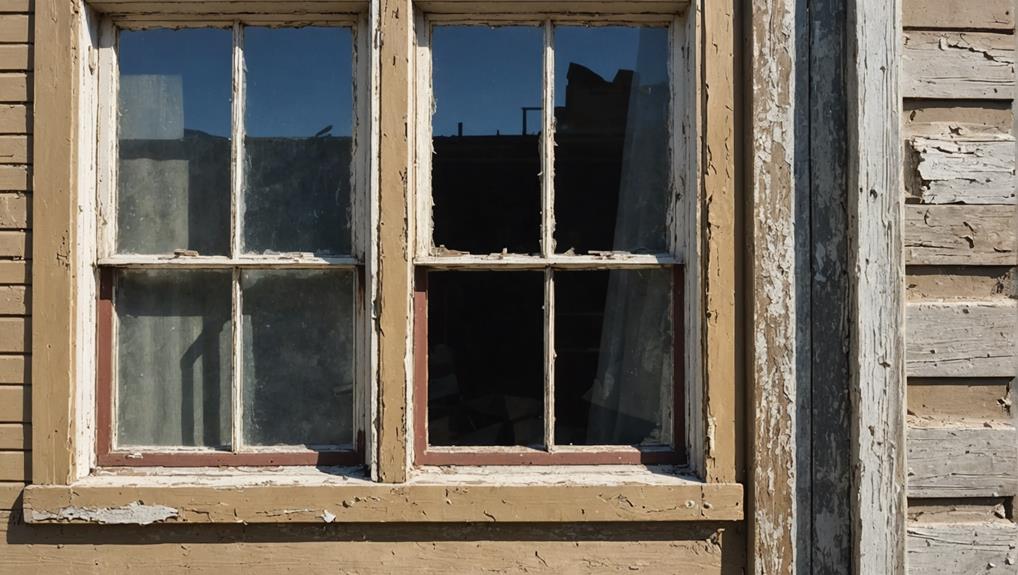
Maintaining vinyl windows is relatively easy, as they require minimal upkeep to keep them looking and functioning their best. To guarantee their longevity, you’ll want to incorporate some effective cleaning techniques. A simple mixture of warm soapy water and a soft cloth is often enough to remove dirt and grime. Avoid harsh chemicals or abrasive materials, as these can scratch the surface. Regularly checking the window seals and tracks helps you catch any potential issues early.
If you notice any cracks or damages, don’t worry; there are straightforward repair tips you can follow. For small cracks, a vinyl repair adhesive can work wonders. Just clean the area, apply the adhesive, and let it cure as per the instructions. If a window becomes difficult to open or close, inspect the tracks for debris or obstructions, and clean them out as needed.
While vinyl windows don’t need paint or staining, a periodic inspection will help you maintain their quality. By following these cleaning techniques and repair tips, you’ll guarantee your vinyl windows serve you well for years to come.
Aesthetic Appeal and Design
When considering window options, you’ll find that vinyl windows come in a variety of styles and colors, allowing you to enhance your home’s aesthetic appeal. These windows are incredibly versatile, matching various architectural styles, from modern to traditional. You can easily find a design that complements your home’s exterior and interior.
One of the major advantages of vinyl windows is the extensive color options available. Whether you prefer classic whites, vibrant hues, or natural wood finishes, there’s something for everyone. This flexibility lets you tailor the look of your windows to suit your personal taste and the overall theme of your home.
Additionally, vinyl windows can imitate the appearance of more expensive materials, giving you the look of wood or metal without the upkeep. This means you can achieve a stylish appearance without sacrificing functionality. With their clean lines and sleek profile, vinyl windows can elevate your home’s curb appeal, making it look polished and inviting.
In short, if you’re looking to boost your home’s aesthetic value, vinyl windows offer a fantastic blend of style, design, and customization options that can meet your needs.
Cost Considerations
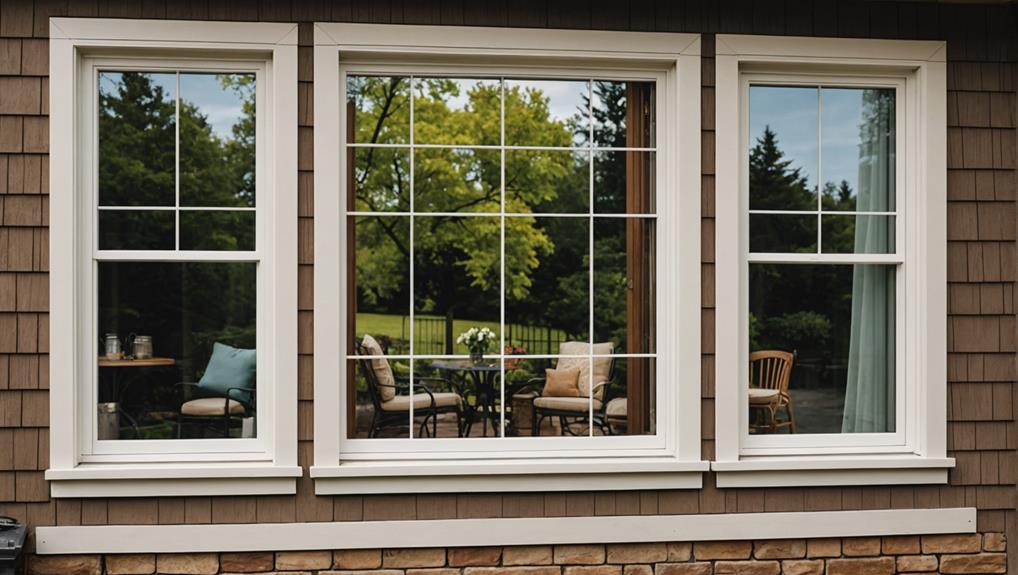
Vinyl windows can help you save money upfront, but it’s important to weigh their initial costs against long-term savings and benefits. While the initial investment may be lower compared to wood or aluminum windows, it’s vital to take into account the potential savings on energy bills over time. Vinyl windows are known for their excellent insulation properties, which can lead to reduced heating and cooling costs.
You’ll also find various financing options available that can ease the burden of upfront expenses. Many manufacturers and retailers offer flexible payment plans, allowing you to spread the cost over time. This can make high-quality vinyl windows more accessible without straining your budget.
Over the years, you’ll likely notice significant savings on energy expenses, which can offset the initial costs. Additionally, vinyl windows require minimal maintenance, translating to fewer costs for repairs or replacements in the long run.
When evaluating the overall cost, think about both the immediate price tag and the long-term savings they provide. By doing this, you can make a more informed decision that aligns with your financial goals.
Environmental Impact
Considering the environmental impact, vinyl windows offer a mix of benefits and drawbacks that you should carefully evaluate.
On the one hand, vinyl windows are made from polyvinyl chloride (PVC), which is a durable material that can last for decades. This longevity means fewer replacements and reduced waste in landfills over time. However, the production process of PVC can have negative environmental effects, including the release of harmful chemicals.
When it comes to sustainability practices, you’ll find that some manufacturers are adopting more eco-friendly methods, such as using recycled materials in their vinyl windows. This can help reduce the overall carbon footprint of the product. Additionally, recycling options for vinyl are becoming more accessible. While many homeowners mightn’t be aware, you can often find programs that recycle old vinyl windows, giving them a second life and keeping them out of landfills.
Ultimately, weighing the environmental impact of vinyl windows involves considering both the production process and the potential for recycling. By staying informed about these factors, you can make a more responsible choice for your home and the planet.
Comparison With Other Materials
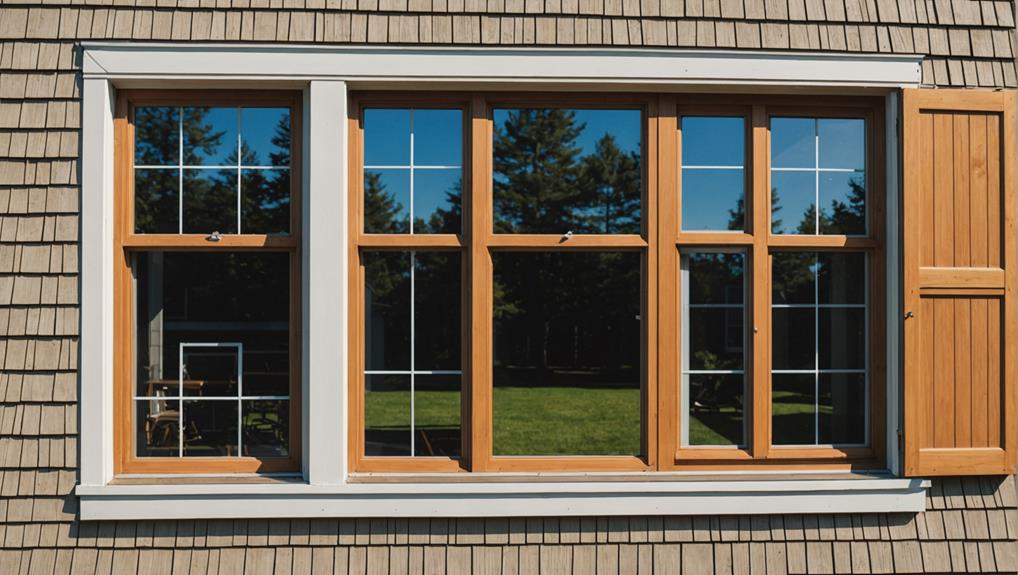
When you’re weighing your options for window materials, it’s essential to take into account cost effectiveness and durability.
Vinyl windows often come out on top regarding price, but how do they stack up against wood or aluminum?
Let’s explore the differences to help you make an informed decision.
Cost Effectiveness
Choosing vinyl windows often proves to be a budget-friendly option compared to alternatives like wood or aluminum. While the initial investment for vinyl windows is typically lower, the benefits extend far beyond just price.
Vinyl windows require minimal upkeep, meaning you won’t spend much on maintenance or repairs over time. This can lead to significant long-term savings, especially when you factor in the costs associated with painting or sealing wood windows.
Additionally, vinyl windows offer excellent energy efficiency, which can lower your heating and cooling bills. You’ll appreciate how this contributes to your overall savings, making vinyl a smart choice for your wallet. When comparing long-term costs, the durability and low maintenance of vinyl windows often outweigh the initial savings of cheaper options that may need replacing sooner.
In essence, while wood and aluminum windows might seem appealing at first glance, the cost-effectiveness of vinyl becomes clear as you evaluate the total costs over time. Investing in vinyl windows means you’re not just saving money upfront, but also ensuring that your home remains energy-efficient and low-maintenance for years to come.
Durability Comparison
While vinyl windows are cost-effective, their durability often outshines that of wood and aluminum, making them a wise investment for long-term performance. When comparing materials, it’s crucial to evaluate factors like weather resistance and lifespan expectations. Here’s how vinyl stacks up against its competitors:
Weather Resistance: Vinyl windows resist fading, cracking, and warping better than wood, ensuring they stand strong against harsh elements.
Maintenance: Unlike wood, vinyl doesn’t require regular painting or sealing, saving you time and money.
Lifespan Expectations: Vinyl windows can last 20-40 years, often surpassing the lifespan of wood and aluminum options.
Energy Efficiency: Vinyl frames provide excellent insulation, helping to maintain your home’s temperature and reduce energy costs.
Cost Over Time: With lower maintenance needs and longer lifespans, vinyl windows prove to be more economical in the long run.
Installation Process Insights
Installing vinyl windows is typically a straightforward process that can be tackled by a skilled DIYer or a professional. If you’re considering a DIY approach, familiarize yourself with proper installation techniques, such as measuring the window openings accurately, making sure the frames are level, and sealing them correctly to prevent drafts.
You’ll need essential tools like a saw, level, and caulk gun, so confirm you have everything on hand before starting.
However, if you’re unsure about your skills or want to guarantee the best results, professional services are always a solid option. They bring expertise and experience, which can save you time and hassle. Pros will handle all aspects of the installation, from removing old windows to making sure everything is properly sealed and insulated.
Regardless of the route you choose, it’s vital to follow local building codes and manufacturer guidelines. This won’t only help you achieve a successful installation but also maximize the longevity and performance of your new vinyl windows.
Ultimately, whether you go DIY or hire professionals, understanding the installation process is key to a smooth experience.

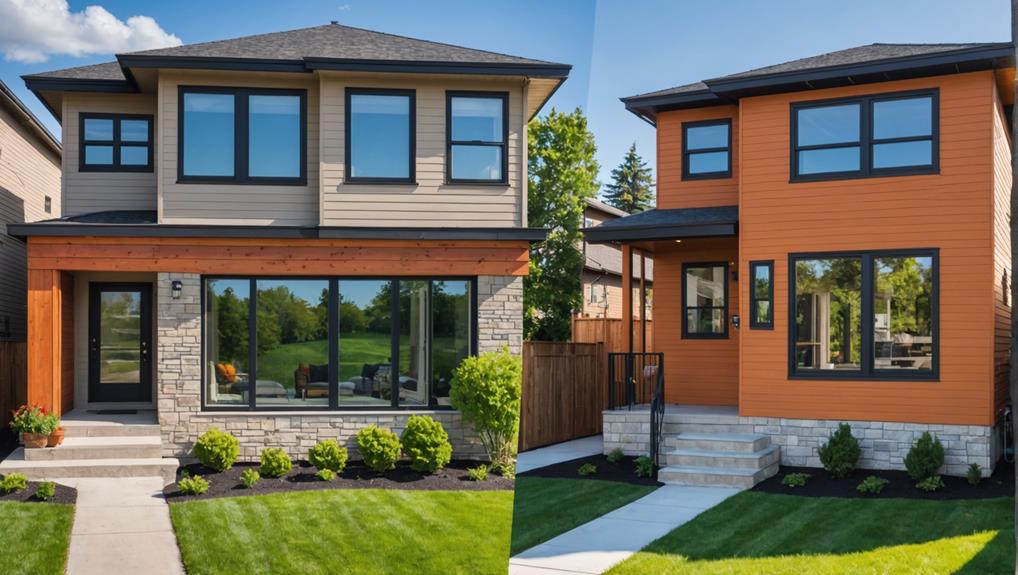
Leave a Reply